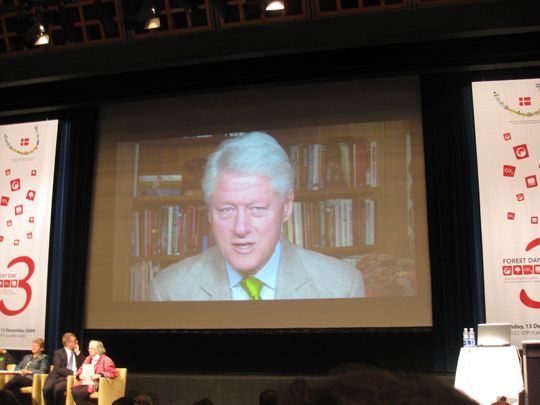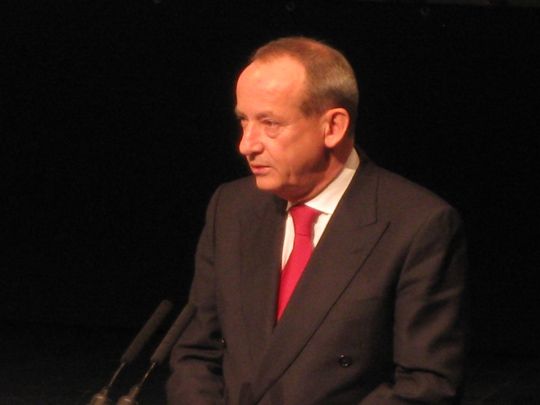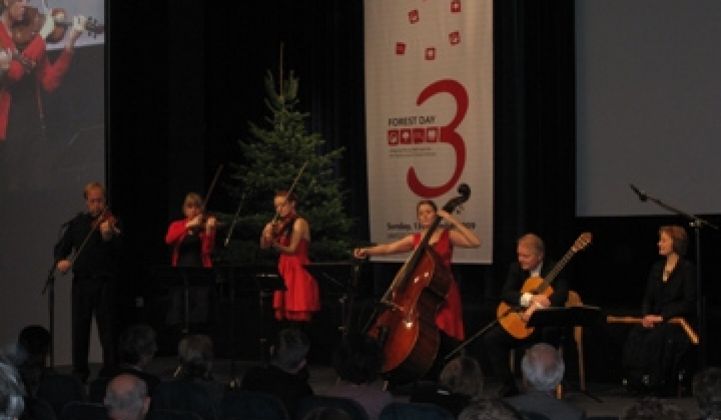Who says money doesn't grow on trees? At the third-annual Forest Day event, held during the Cop15 Climate Summit in Copenhagen, attendees were a buzz about going green and making green, all with a new forestry protocol called REDD.
Short for "Reducing Emissions from Deforestation and Degradation," REDD aims to make a tree worth more standing up then cut down. It accomplishes this by monetizing the carbon sequestration benefits of trees in the form of carbon credits. Or, to put it another way: REDD is a mechanism to grow money on trees.
In contrast to the many monotonous sessions that characterize COP-15, the Forest Day 3 conference kicked off with a mini concert from the Mermaid orchestra, a six-piece classical group who performed Ave Maria and other melodies (see picture above). With music in the air, and the prospect of REDD being adopted and formalized in the Cop15 process, conference attendees had good reason to be optimistic.
Putting a Price on Carbon
Given that many believe a cap and trade system is eminent, REDD offers opportunities to create inexpensive carbon credits that can be sold to companies who exceed their emissions allowances. This potential doesn't come without some concerns. In her welcoming remarks, Frances Seymour, Director General for the Center for International Forestry Research (CIFOR) encouraged the audience to think bigger then carbon. "We need to look at forests as more then just carbon storage and talk about biodiversity retention, indigenous people's rights and other issues," said Seymour.
In addition, most in attendance seemed to acknowledge the real sense of urgency presented by climate change issues. "These are the most critical negotiations we have seen in decades. Cop15 has the attention of the world and forestry is at the center of the negotiations," said Troels Lund Poulsen, Minister for the Environment of Denmark.
"Forests can and must play a major role in solving our climate crisis." said former President Bill Clinton in a video-taped message. "Through REDD, forests can provide an income stream for forest rich countries," he added.
The topic of enrichment was a popular theme during several presentations. "REDD is a mechanism for transferring funds from developed to developing nations. Therefore, transparency and safeguards are clearly needed," said Gro Harlem Brundtland, United Nations Special Envoy on Climate Change.
With all of this talk about transferring wealth, one might wonder why rich nations should be paying developing countries not to chop down their rain forests. Aside from the scientific arguments (trees absorb the carbon from our CO2 pollution), as well as the equity arguments (rich countries should take responsibility for cleaning up the mess they created), there is one other perspective worth considering. What if REDD represents an opportunity to reconsider the mechanism we use to place value on natural resources?
The Value of Nature
In our current model, we place value on the things we extract from nature. If you harvest a tree, or pump a barrel of oil out of the ground, you can sell those commodities and use them in an industrial process. With cap and trade, a price is established for carbon emissions. Free pollution is no longer free. As a result, value is created when carbon is removed from the environment.
In the case of a forest, it could be suggested that the countries that are lucky enough to have inhabited environments rich in forest resources should just give this commodity away to the world. Of course, this position makes about as much sense as saying that OPEC countries should just "give away" their natural resources. While oil takes significant investment and effort to extract from the ground, it should be noted that forest management also requires significant effort and capital expenditures.
In the U.S., it might be possible to rope off the forest and attach a simple "do not disturb" sign. However, in many forest rich countries, the danger from illegal foresting is significant. In fact, hiring armed guards to protect the forest is not unheard of in some countries. In addition, the cost of fire protection services needs to be considered.
By placing value on carbon sequestration, we are, in essence, incentivizing a shift from fossil fuels to alternative energy. The question is: Would you rather be shipping your money to forest rich countries or oil rich countries? Which natural resource should we be supporting?
Counting the Carbon
While it might sound great to save trees and reduce our demand on fossil fuels, one of the challenges faced by REDD is in measurement and verification. As consumers, we are more comfortable with the idea of paying for oil (versus paying for carbon sequestration) because it's something we can easily measure and verify. In other words, we can put it in a barrel or pump a gallon into our cars. A barrel of oil or a gallon of gasoline is something that can be commoditized and sold in an open market.
Until carbon can be measured as easily as oil or gasoline, and carbon claims can be audited and verified with reasonable assurance, it will be difficult for forestry protocols to gain acceptance. Numerous efforts are underway to tackle this problem, ranging from ground based sensors to satellite imagery. However, more work is needed.
Forestry Day 3 in Copenhagen demonstrates the considerable momentum behind forestry conservation. With the right combination of financial incentives and safeguards, it may very well be possible to leverage capital markets to save the rainforest. It just goes to show that the environmental and business communities can hold hands – even while they're hugging trees.
Lee Barken, CPA, LEED-AP is the IT practice leader at Haskell & White, LLP and serves on the board of directors of CleanTECH San Diego and the U.S. Green Building Council – San Diego chapter. Lee writes and speaks on the topics of carbon accounting, green building, IT audit compliance, enterprise security and wireless LAN technology. He is currently in Copenhagen attending the Cop15 conference. You can reach him at 858-350-4215 or [email protected].

Left to Right: Jan Heino, Dr. Rajendra Kumar Pachauri, Gro Harlem Brundtland, Troels Lund Poulsen, Elinor Ostrom

President Bill Clinton

Dr. Rajendra Kumar Pachauri, Chair, IPCC

Gro Harlem Brundtland, UN Special Envoy on Climate Change

Yvo de Boer, Executive Secretary UNFCCC



